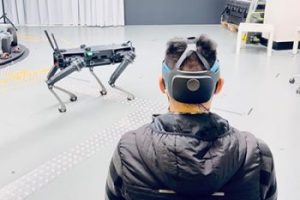
Whilst expensive versions exist today – the joysticks of fly-by-wire aircraft are an example, the university claims that its offering, branded Mantis, is “a lightweight, affordable and simple solution for everyday users. Theoretically, the Mantis could be built and used by anyone upwards from a secondary school student.”
Force is fed to the user through arms (see photo) pushed by stalled electric motors – altering the current through a motor varies the amount of torque it applies when stalled.
 A significant part of cost-reduction comes through using standard brush-less dc motors (zhxyrc X8308S drone motors, left) instead of precision ‘core-less’ dc motors.
A significant part of cost-reduction comes through using standard brush-less dc motors (zhxyrc X8308S drone motors, left) instead of precision ‘core-less’ dc motors.
Core-less motors have no iron around their windings and therefore do not suffer from ‘cogging’ – mechanical pulses in rotary torque caused by the interaction of magnets and steel within their structure.
Combined with the way that some core-less motors are wound, where a arbitrary input current will provide a predictable output torque from the stalled motor, this lack of cogging allows a current-based open-loop control system to be implemented.
Such open-loop control is impossible with standard (iron-backed coil) brush-less dc motors as the torque is not proportional to input current, so the researchers introduced local force feedback: sensing force in three dimensions where the robot arm interacts with the human operator to allow motor current to be fine-tuned – with a fast (milliseconds) time-constant.
Once this local feedback exists, other effects, such as the inertia, resistance or weight in the motor and arm, can be compensated for – effectively deleting any sense that the operator is touching the local robot arm mechanism, while allowing forces to be applied that are, for example, proportional to the force some remote robot is applying to a scalpel, or indicating the strength of a virtual force created in a software world.
Whilst four arms and four motors are shown in the photo, the Bristol concept is generalised to work with one arm or many arms, and from short arms (where space is an issue) to long arms (when the operator need to make extravagant movements.
Where force needs are low, the team proposes direct coupling between motor shaft and arm, or connection through toothed belts and pulleys where torque must be multiplied. Geared connections are another possibility if backlash is dealt with, and strain wave or cycloidal drives are further options.
“Humans already have a great sense of touch,” said lead researcher Dr Anne Roudaut. “Imagine a user playing a game in virtual reality with Mantis attached to their fingers. They could touch and feel virtual objects, thus immersing themselves both visually and physically in an alternative dimension.”
Roudaut is presenting Mantis to the User Interface Software and Technology (UIST) conference in New Orleans this week in the paper ‘A scalable, lightweight and accessible architecture to build multiform force feedback systems‘.
Company Senmag Robotics has been spun-out to take the concept to market – starting with kits scheduled to be available by the end of the year.
“We will be giving out the plans to allow anyone to build a Mantis,” said fellow researcher Gareth Barnaby, who will also be at UIST. “Because we are keen to make force feedback devices more widespread and not confined to research labs, we are also looking to produce some easy to build kits as well as pre-built versions that we will make available on the website.”
The work was supported by the Engineering and Physical Sciences Research Council (EPSRC) and the Leverhulme Trust.
 Electronics Weekly Electronics Design & Components Tech News
Electronics Weekly Electronics Design & Components Tech News



